NVIDIA GeForce GTX 760 Review: The New Enthusiast Kepler
by Ryan Smith on June 25, 2013 9:00 AM ESTOverclocking GTX 760
Like the GTX 770 last month, the GTX 760 is clocked relatively high. Its 980MHz base clock is 65MHz higher than either the GTX 670 or GTX 660 Ti. As a result some of the overclocking headroom that we would expect has been eaten into by the overclock. Yet on the other hand the higher voltage for the highest boost bin – 1.2v versus 1.175v – gives us some additional overclocking headroom as long as our cooling can keep up.
At the same time the GTX 760 gets a slightly larger TDP adjustment window than most other GK104 parts. Here we can push the TDP up by up to 15%, from 170W to 195W. This is actually more than the GTX 770, so in TDP limited scenarios we should have a slightly easier time hitting the higher boost bins.
| GeForce GTX 760 Overclocking | ||||
| Stock | Overclocked | |||
| Core Clock | 980MHz | 1130MHz | ||
| Boost Clock | 1033MHz | 1183MHz | ||
| Max Boost Clock | 1149MHz | 1306MHz | ||
| Memory Clock | 6GHz | 6.5GHz | ||
| Max Voltage | 1.2 | 1.212v | ||
In practice GTX 760 ended up exceeding our expectations. In fact it even ended up exceeding GTX 770 with regard to the size of the overclock and the highest boost bin we reached. Altogether we were able to increase the core clock by 150MHz on our GTX 760 sample, going from a base clock of 980MHz to 1130MHz. At the same time our max boost clock went from 1149MHz to 1306MHz, making this the first Kepler we’ve seen to surpass 1300MHz. The end result is that core overclocking ends up being more potent than we were expecting.
Meanwhile the memory overclock is fairly standard for a GK104 part. It’s something of a roll of the dice, and in this case we were able to hit 6.5GHz before memory performance started regressing. Thus we’re altogether looking at a 15% core overclock coupled with a milder 8% memory overclock.
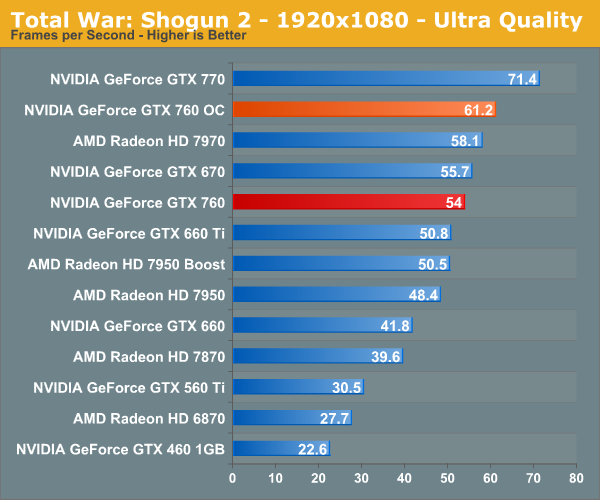
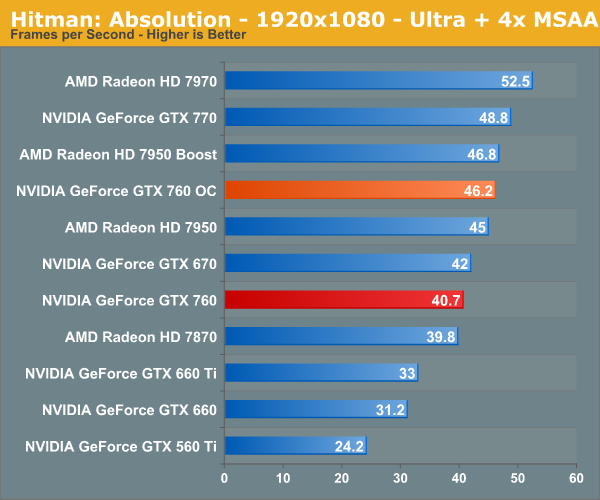
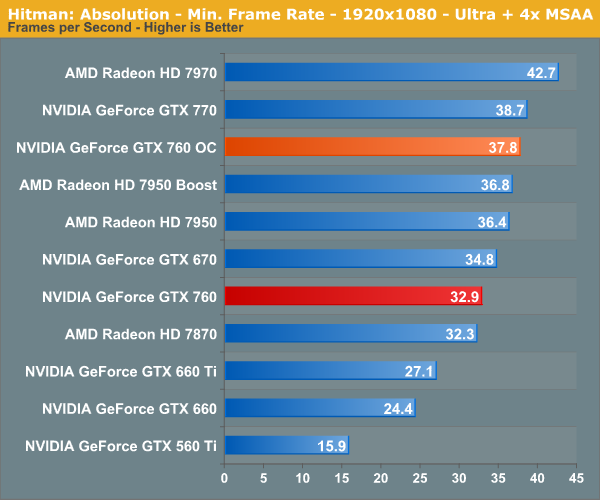
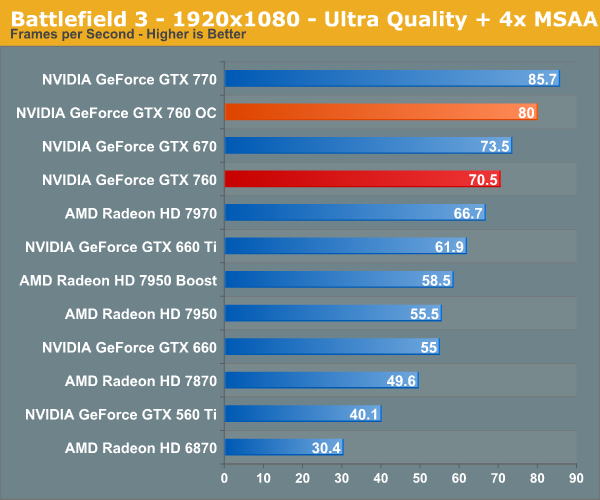
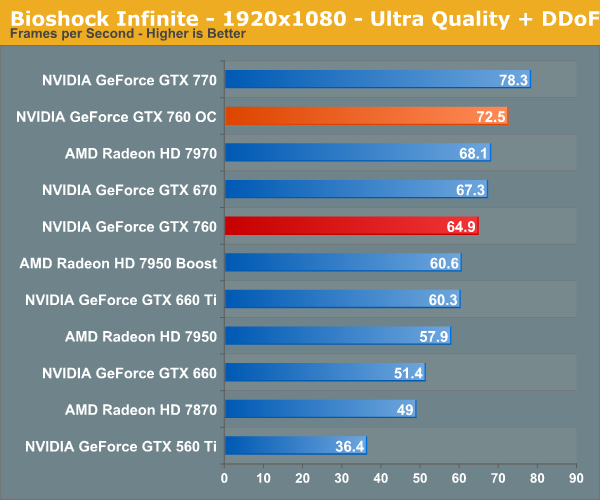
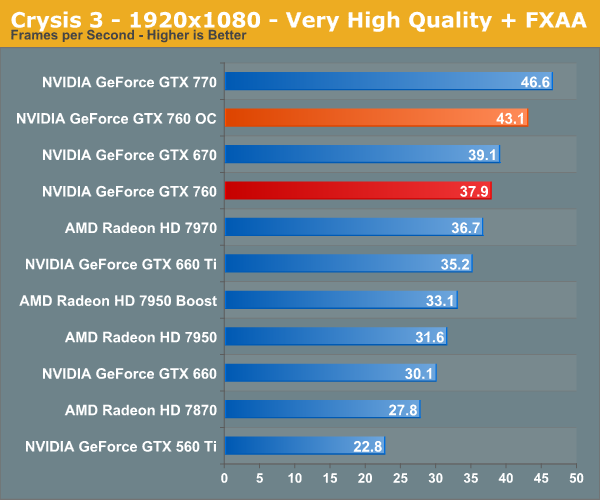
Given GTX 760’s base shader/texture performance deficit due to only having 6 SMXes, overclocking proves to be very effective on our final results. The performance gains in all 5 of our games were on the order of 12% to 14%, just a bit less than the core overclock itself. With the wide gap between the GTX 770 and GTX 760 in terms of specs this generally isn’t enough to completely catch up to NVIDIA’s top-tier GK104 card, but it can erase a large portion of the gap.
The end result of this overclock won’t dramatically change the GTX 760’s performance profile, but it should help to push it over 60fps in those situations where performance at 1080p at ultra quality settings was marginal. Or from a fixed performance standpoint, we’re approaching Radeon HD 7970 performance with this overclock.
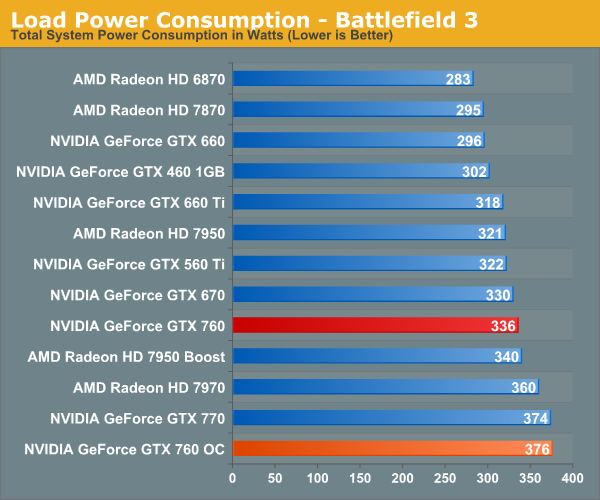
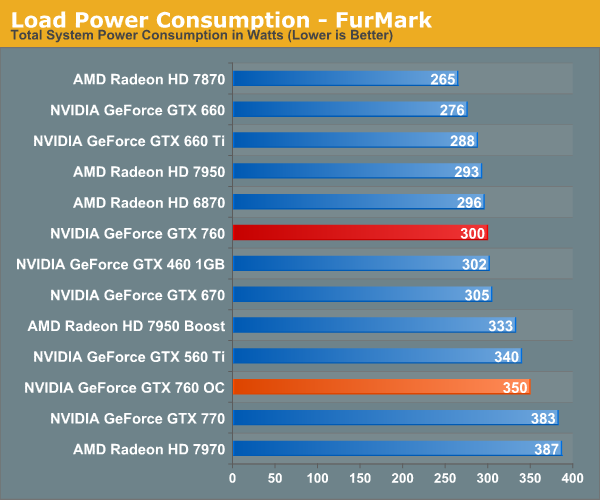
Moving on to power consumption, increasing our TDP has the expected hit. GTX 760 of course has a larger adjustment window than GTX 770, so the increase in power consumption ends up being noticeably larger. Overclocking in this manner pushes the GTX 760 off of the power/performance efficiency curve to some degree, so the GTX 760 loses its edge in that respect.
The end result is that power consumption at the wall jumps by 40W under BF3, and 50W under FurMark. This is tied with and better than the stock GTX 770 respectively, though as we’ve already seen it doesn’t match the GTX 770’s rendering performance. Furthermore as we’ll see, cooling is going to play a big factor here, with the reference GTX 760 cooler not always being the best choice for overclocking.
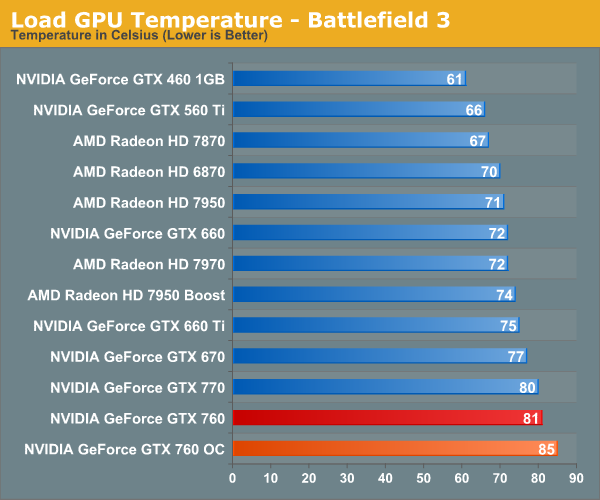
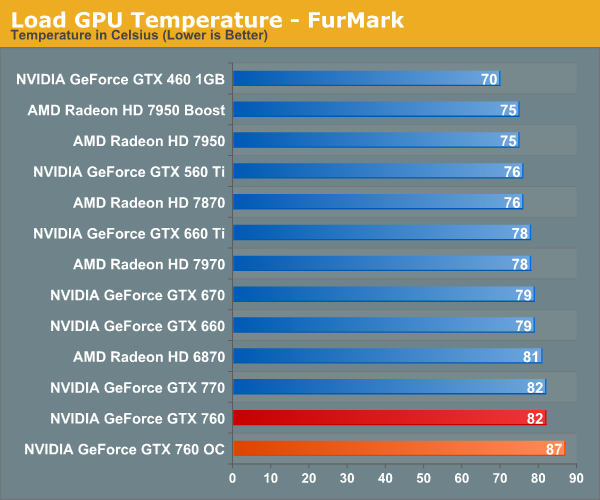
With the temperature limit raised to 95C, the reference GTX 760 cooler reaches equilibrium at 85C under BF3 and 87C under FurMark. These temperatures are still easily within spec for GK104, but they’re definitely starting to crawl up here. Meanwhile, though it’s not directly measurable the impact of leakage is certainly making itself felt here. If we had cooler temperatures power consumption would at least be marginally lower.
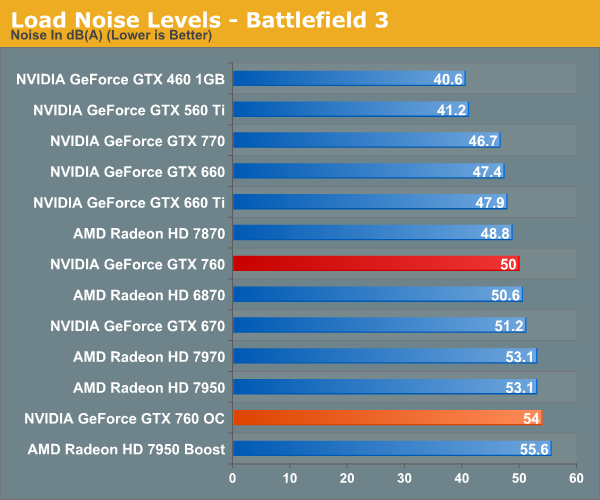
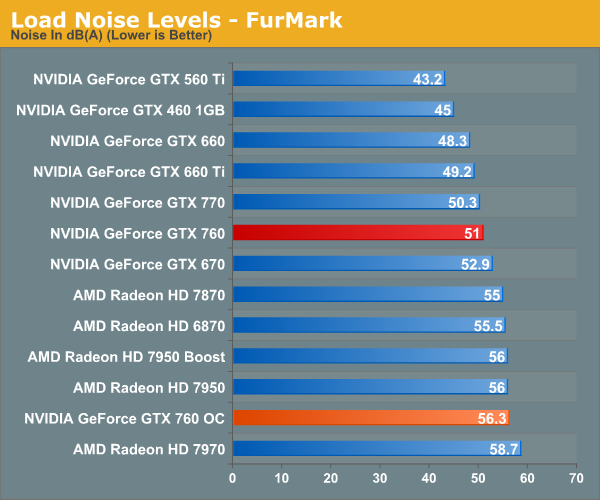
Finally we noise we can see that those new equilibriums also come at new, much higher noise levels. The reference cooler can keep up with the higher heat load created by overclocking, but it’s having to work hard to do so. These noise levels aren’t terrible – in fact they’re about even with the reference 7950 – but they do represent a real cost in terms of noise. Consequently, unlike NVIDIA’s Titan cooler that comes with the reference Titan, GTX 780, and GTX 770, when it comes to GTX 760 there’s very clearly room for improvement with custom coolers.










110 Comments
View All Comments
kennyG - Tuesday, June 25, 2013 - link
I for one was not happy with the out come of the 760 tested . I wanted Nvidia to totally take the 670 and enhance it and make a 760..Do the same process like they did with the 680 to 770. I really wanted to buy this card... Waiting for this one and I'm pisssed.Laststop311 - Tuesday, June 25, 2013 - link
I wonder how 2 of these(500) in sli compared to the GTX 780 single gpu (650)xTRICKYxx - Wednesday, June 26, 2013 - link
About Titan/GTX 690 levels.Ribozyme - Tuesday, June 25, 2013 - link
Ryan, could you please elaborate why the 760 draws considerably more power than a 670 while still being slower? Is this because a lower clocked 670 is compared to a pretty high clocked 760 in comparison? What would the situation be if you compared a 760 to a 670 clock per clock? And would I be able to power this with a be quiet straight power e9 400w + 3770k folding 24/7 ?And last question, are your power consumption values measured from the socket with a watt meter or with ampere meter on each cable and then added up?
Ryan Smith - Tuesday, June 25, 2013 - link
The biggest difference between the 760 and 670 is that the 760 has GPU Boost 2.0, which is a significantly different method of adjusting clockspeeds around temperature and power limits. The 670 had a TDP of 170W, but in practice its power target (a concept that doesn't exist with Boost 2.0) was below that. Whereas the GTX 760, if not constrained by temperatures, will get closer to its 170W TDP more frequently.The other difference is as you note: clockspeeds. The GTX 760 has fewer SMXes, but it operates at a higher clockspeed and with higher voltages (1.2v vs. 1.175v). That really eats up power at the highest boost bins. The 760 is essentially a little less wide and a little deeper than 670; clock for clock the 670 is going to be faster (but it won't be able to clock quite as high).
As for your PSU question, I'm afraid I can't answer that in any confidence. Based on specs I'd think that would work, but I don't know anything about that PSU.
Finally, power consumption is measured at the wall.
JimmiG - Wednesday, June 26, 2013 - link
Many non-reference GTX 670's boost higher, though. For example, my KFA² GTX 670 almost always boosts to 1,189 MHz, sometimes higher. If you can find a cheap, non-reference GTX 670 before they go out of stock, it might be a better deal.vision33r - Tuesday, June 25, 2013 - link
The last 3 years we saw really no innovation in the desktop GPU market. If you bought a HD 5870, you can still rock that card today in every game without any issue. We will see most of today's card get tossed when 4k monitors become a reality. Even SLI/CF top end cards today will score sub 30fps when games are played natively at 4k res.Kutark - Tuesday, June 25, 2013 - link
Ive been looking for the right price point to upgrade my GTX570, especially with BS4 coming out soon. I was hoping this would be it, but it looks like its really not enough of a jump to justify $250, especially when i could put that money towards a PS4 for some of the console games that wont be ported to PC. Any opinions otherwise?Kutark - Tuesday, June 25, 2013 - link
Haha, meant to say BF4, but yah, you get what i meant lol.mapesdhs - Tuesday, June 25, 2013 - link
:D That was a good one. :)
I suppose it depends on what you want from an upgrade. Are you looking for at
least a 2X speedup? If so then yes, atm you'd probably have to aim higher than
a 760. Indeed, I have a hunch that 570 SLI might match a 770 (that's an option I
suppose, get a 2nd used 570 for the interim).
Ian.